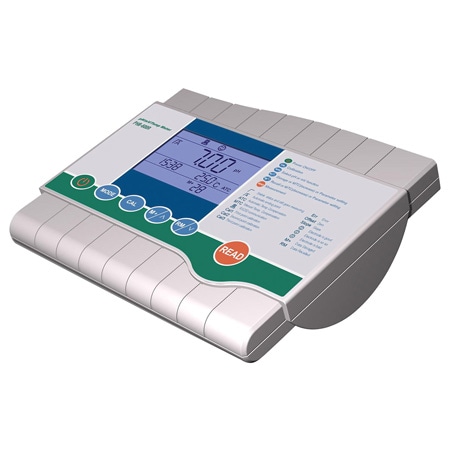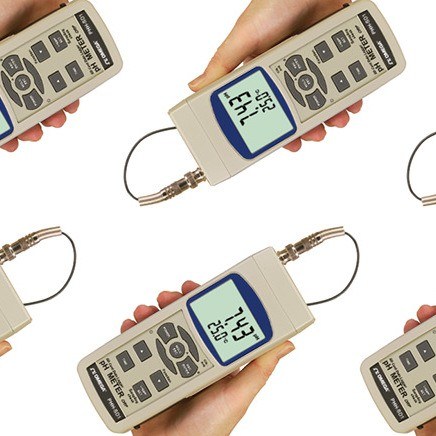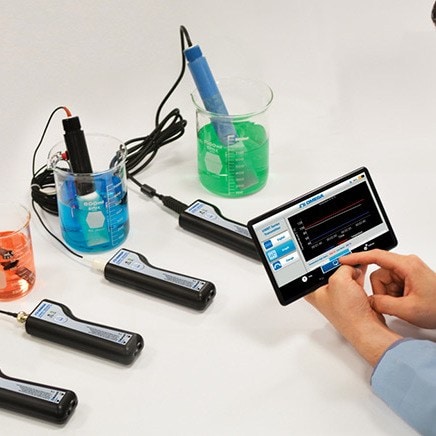An Ion Selective Electrode (ISE) is a specialized type of sensor used to measure the concentration of specific ions in a solution. It is engineered to be selectively sensitive to a particular ion, allowing for precise measurements while remaining largely unaffected by other ions present in the solution.
 An ISE operates by generating an electrical potential (or a voltage) that is directly related to the concentration of the target ion. This potential is typically calculated using the Nernst equation – which establishes the relationship between the ion concentration and the voltage response. Because they are carefully engineered to be selectively sensitive to a particular ion, ISEs are ideal for applications where precise ion concentration data is required, such as in environmental testing, water quality monitoring, and laboratory analysis.
An ISE operates by generating an electrical potential (or a voltage) that is directly related to the concentration of the target ion. This potential is typically calculated using the Nernst equation – which establishes the relationship between the ion concentration and the voltage response. Because they are carefully engineered to be selectively sensitive to a particular ion, ISEs are ideal for applications where precise ion concentration data is required, such as in environmental testing, water quality monitoring, and laboratory analysis.
Advantages
- Selective and specific: ISEs can measure specific ions without interference.
- Real-time measurements: ISEs provide continuous, on-site analysis.
- Wide range of applications: ISEs can be used for various types of samples (liquids, solutions, etc.)
Limitations
- Calibration required: ISEs need to be calibrated with standard solutions of known ion concentrations.
- Interference: In some cases, other ions with similar properties may interfere with measurements - though modern electrodes are designed to minimize such effects.
Measurement Considerations
When using ion-selective electrodes (ISEs) for analytical measurements, it is important to recognize that several factors must be carefully considered to ensure accurate results. These considerations can influence the performance and reliability of the electrode, as various external conditions and intrinsic properties can impact the measurement. Proper attention to these factors is essential for obtaining meaningful data and ensuring the electrode's longevity and effectiveness in diverse applications.
Agitation
When carrying out selective ion measurements, it is important to have good agitation. This allows a fresh supply of ions to be exposed to the sensing portion of the ISE. It is best to select a speed that keeps a constant, smooth motion. A turbulent rate should be avoided.
Sample pH
Most ISE's require a specific pH range for optimum performance of the electrode. Some ISE's require a precise adjustment. Consult OMEGA's pH Engineering staff for details on purchasing a pH adjustment reagent formulated for your particular electrode.
Response Time
ISE's require a much longer time for the readings to stabilize. At least fifteen minutes should be allowed for equilibrium to be established when measuring your standard solutions.
Establishing a Calibration Curve
It is recommended to use three standard solutions when establishing a calibration curve. To choose the concentrations of the standard solutions it is helpful to know the approximate values of your unknown solutions. For example, if your unknown solutions are in the 100 ppm range, the choice of standards may include a 10 ppm, a 100 ppm, and a 1000 ppm solution.
Rinsing
It is necessary to rinse the ISE between measurements to insure accurate readings. Use a steady stream of deionized or distilled water. Take care not to rub the electrode with a cloth to dry the probe. It is usually best to "shake off" any excess water. Take care not to hit the probe against anything while shaking the electrode.
Conditioning
The ISE needs to remain moist at all times even when not in use. Consult the operator's manual that accompanies your electrode for details on cleaning, conditioning and storing the ISE. Common Questions and Answers About Ion-Selective Electrodes
What is an Ion-Selective Electrode?
An Ion Selective Electrode measures the potential of a specific ion in solution. (The pH electrode is an ISE for the Hydrogen ion.) This potential is measured against a stable reference electrode of constant potential. The potential difference between the two electrodes will depend upon the activity of the specific ion in solution. This activity is related to the concentration of that specific ion, therefore allowing the end-user to make an analytical measurement of that specific ion. Several ISE's have been developed for a variety of different ions.
What Type of Equipment is Needed for an ISE Measurement?
A pH meter that also measures millivolts can be used to interface with an ISE. Most ISE's are combination electrodes that have the reference electrode built into the body of the ISE, however, some ISE's require a separate reference electrode. If this is the case, the pH/mV meter must have a pin-connector to connect the reference electrode.
How Does the mV Reading Correspond to the Concentration?
Standard solutions of known concentrations must be accurately prepared. These solutions are then measured with the pH/mV meter. The mV reading of each solution is noted and a graph of concentration vs. mV reading must be plotted. Now the unknown solution can be measured. The mV value of the unknown solution is then located on the graph and the corresponding solution concentration is determined. Please see the graph shown above as an example.
What is Ionic Activity?
Ionic activity is a thermodynamic measurement that represents the energy available due to free and reactive ions in solution. The activity coefficient is the ratio between the free ions and the total ionic concentration in the solution.
Why is pH Adjustment Necessary?
I n many cases pH control is necessary for accurate, repeatable measurements. Certain ions exhibit different activity when different concentrations of hydrogen ions are present in solution. This occurrence will not only alter the potential due to the specific ion that is measured, it may also allow other ions in solution to become active that otherwise were not. This increased activity from the other ions will interfere with the ability to evaluate the ion of interest.


